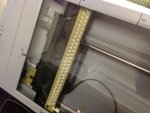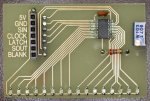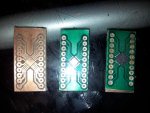1. print off artwork using a laser printer (Brother brand doesn't work). You want to use the thinnest, least absorbent paper you can find. Glossy magazine paper is clay based and will not absorb the toner. Since I don't have a printer, i've been using lightweight gloss paper from a fedex office 24hour print center, with excellent results.
1. scrub the copper with Scotchbrite 7447 pad until it is completely clean, bare copper. (no, don't use steel wool. we don't want to rub steel into the copper... 7447 is aluminum oxide)
2. clean copper with rubbing alcohol until paper napkin/towell is clean
3. use a hot laminator to fuse the toner to the copper, run it through like 10 times (no, not 3). If you don't have a laminator don't waste your time by reading further. I use one of these and got it for $30 shipped http://www.google.com/products/catalog?q=gbc+9+creative+laminator&hl=en&safe=off&prmd=imvns&bav=on.2,or.r_gc.r_pw.r_qf.,cf.osb&biw=1228&bih=810&um=1&ie=UTF-8&tbm=shop&cid=16159181314241537830&sa=X&ei=bW6FT96LFqml8AGCvsCUCA&ved=0CG0Q8wIwAw
4. soak in water for a few minutes to help release the paper. You might have to scrub the paper with your fingers to get all the pulp off, don't worry, the toner isn't going to come off.
5. I lightly scrub the remainig pulp off using the scotchbrite pad to get down to the toner, I do this because I laminate Green TRF foil onto the toner to completely seal it. This only needs like 4 passes through the laminator.
6. lightly scub the board with the scotchbrite to remove any traces of un-bonded green TRF foil.
7. touch up any areas that require it using a sharpie permanent marker.
8. etch. I use muratic acid (31%) and hydrogen peroxide. 50/50 mix or slightly more peroxide than acid.
9. agitate while etching. if you just let it sit there it's going to take forever and your resist will deteriorate. you want to etch as quickly as possible. I use a sponge paintbrush and repeatedly wipe the copper very gently. This exposes new copper with each swipe and will etch the board in 5 minutes or less.
10. remove resist with acetone or brake cleaner, and give it a final scrub with scotchbrite to really clean the copper.
11. drill holes
I may have missed something... feel free to alter or add anything but you may get worse results.
1. scrub the copper with Scotchbrite 7447 pad until it is completely clean, bare copper. (no, don't use steel wool. we don't want to rub steel into the copper... 7447 is aluminum oxide)
2. clean copper with rubbing alcohol until paper napkin/towell is clean
3. use a hot laminator to fuse the toner to the copper, run it through like 10 times (no, not 3). If you don't have a laminator don't waste your time by reading further. I use one of these and got it for $30 shipped http://www.google.com/products/catalog?q=gbc+9+creative+laminator&hl=en&safe=off&prmd=imvns&bav=on.2,or.r_gc.r_pw.r_qf.,cf.osb&biw=1228&bih=810&um=1&ie=UTF-8&tbm=shop&cid=16159181314241537830&sa=X&ei=bW6FT96LFqml8AGCvsCUCA&ved=0CG0Q8wIwAw
4. soak in water for a few minutes to help release the paper. You might have to scrub the paper with your fingers to get all the pulp off, don't worry, the toner isn't going to come off.
5. I lightly scrub the remainig pulp off using the scotchbrite pad to get down to the toner, I do this because I laminate Green TRF foil onto the toner to completely seal it. This only needs like 4 passes through the laminator.
6. lightly scub the board with the scotchbrite to remove any traces of un-bonded green TRF foil.
7. touch up any areas that require it using a sharpie permanent marker.
8. etch. I use muratic acid (31%) and hydrogen peroxide. 50/50 mix or slightly more peroxide than acid.
9. agitate while etching. if you just let it sit there it's going to take forever and your resist will deteriorate. you want to etch as quickly as possible. I use a sponge paintbrush and repeatedly wipe the copper very gently. This exposes new copper with each swipe and will etch the board in 5 minutes or less.
10. remove resist with acetone or brake cleaner, and give it a final scrub with scotchbrite to really clean the copper.
11. drill holes
I may have missed something... feel free to alter or add anything but you may get worse results.
Last edited:



